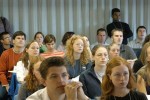In October 2007, Amy Burgin (KBS) transitioned out of her position as LTER graduate student co-chair, and Amber Hardison (VCR) was elected in her place. Amy was a strong leader in the LTER, and during her time as co-chair she helped organize the "2nd LTER Collaborative Graduate Student Symposium" at the 2006 All-Scientists Meeting (ASM) at Estes Park, CO, and co-hosted a post-ASM workshop at KBS in April 2007. We thank Amy for her commitment to facilitating graduate student collaborations within the LTER community.
Meanwhile, John Kominoski (CWT) will serve out his term as LTER graduate student co-chair in May 2008, and will be succeeded by Chelse Prather (LUQ). Nevertheless, John and Chelse will organize an informal LTER graduate student social at the 93rd annual meeting of the Ecological Society of America in Milwaukee, WI, in August 2008. Look for future correspondence about this event, and please join your fellow graduate students to provide feedback, discuss issues, and meet new colleagues.
LTER graduate students conduct diverse research across the globe, volunteer with educational outreach programs, and promote interdisciplinary science within and beyond the LTER community. Below is a snapshot of some graduate student activities and initiatives.
Heidi Geisz (PAL) has just published a paper in Environmental Science and Toxicology entitled "Melting Glaciers: A Probable Source of DDT to the Antarctic Marine Ecosystem". Kristen Gorman, an experienced PAL technician and new graduate student, will spend the better part of six months in the Antarctic this year helping PAL scientists Hugh Ducklow and Matthew Ericson develop a winter investigation of the microbial biology in the Western Antarctic Peninsula.
Graduate students from KBS and Michigan State University (MSU) organized a forum to discuss ways to reach out to other graduate students at the East Lansing campus. These students have identified a need to inform non-LTER graduate students about the opportunities of collaborating with KBS and the LTER Network. To facilitate a stronger connection between KBS and MSU, Uri Levine, a non-LTER graduate student, has been selected as a graduate student co-representative for KBS. Additionally, the GK-12 program at KBS completed its second successful school year by partnering with area rural school districts to enhance ecological literacy in K-12 classrooms. Several KBS graduate students are GK-12 Fellows, including Todd Robinson, Sara Syswerda, and Brook Wilke. Eight new GK-12 Fellows will start in the GK-12 program at KBS this summer.
Nancy Muehllehner (MCR) is studying the plasticity of biomineralization in scleractinian corals in French Polynesia to assess whether morphological plasticity plays a role in the response of the coral species, Acropora hyacinthus and A. pulchra, to changing carbonate concentrations in seawater. These studies have expanded to include a study of the interacting effects of increased temperature and reduced carbonate in seawater on photosynthesis and calcification in two major reef building species of the Pacific, Porites rus and Pocillopora meandrina.
Graduate students at NTL sponsored a symposium highlighting graduate student research associated with the eleven LTER focal lakes. Graduate research at NTL spans a range of spatial scales from microbial community response to disturbance, to estimates of secondary production for an entire lake, to human development patterns in a lake-dominated landscape in northern Wisconsin. Research highlights include: mapping ground and surface water flow paths in the Northern Highlands Lake District to explore the effect of aquatic linkages on carbon processing; exploring effects of the invasive aquatic plant Eurasian watermilfoil (Myriophyllum spicatum) on lakefront property values; and using paleolimnology-the study of past freshwater, saline, and brackish environments-to link the effects of deforestation associated with European settlement on lake eutrophication by examining biological and geochemical pathways by which phosphorus is stored, processed, and released from lake sediments.
The symposium attracted graduate students, faculty, and staff from across the University of Wisconsin-Madison campus and affiliates from the Wisconsin Department of Natural Resources and the United States Geological Survey. Student presenters hailed from seven different departments: the Nelson Institute for Environmental Studies; Civil and Environmental Engineering; Limnology and Marine Science; Zoology; Environmental Chemistry and Technology; Agriculture and Applied Economics; and Geology and Geophysics. The meeting highlighted the cross-disciplinary nature of research conducted by graduate students associated with NTL and brought together social, natural, and physical scientists from all across the campus.

 Enlarge this image
Enlarge this image